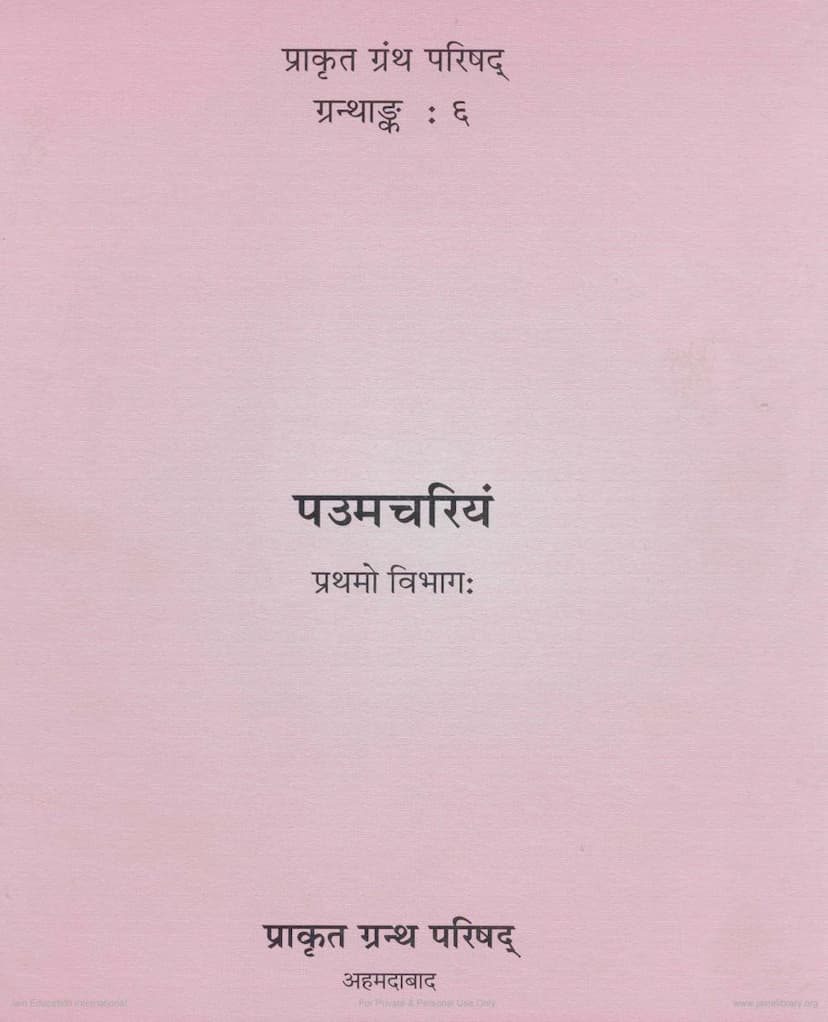Paumchariyam Part 1
Added to library: September 2, 2025

Summary
Here is a comprehensive summary of the provided Jain text, "Paumchariyam Part 1":
The text "Paumchariyam Part 1" is a significant Jain work, attributed to Acharya Vimalasuri. This particular publication is the first part of the work, released by the Prakrit Granth Parishad, Ahmedabad. The catalog link provided leads to a digital version of this edition.
Key Information from the Provided Pages:
- Title: Paumchariyam (पउमचरियं), First Part (प्रथम विभागः)
- Author: Acharya Shrivimalasuri (आचार्य श्रीविमलसूरीश्वरजी म.सा.)
- Editors/Revivers: Dr. H. Jacobi (original editor of the first edition), Muni Shri Punyavijayaji (re-editor of this edition).
- Publisher: Prakrit Text Society, Ahmedabad.
- Date of Original Composition (as per Vimalasuri's statement): Approximately 530 years after the Nirvana of Lord Mahavira, which scholars place around the 3rd-4th century CE, though there is scholarly debate on the exact dating (ranging from 1st century CE to later centuries).
- Language: Prakrit (specifically Jaina Mahārāṣṭri Prakrit, considered archaic).
- Subject Matter: The text is a Jain version of the Ramayana story, known as "Jain Ramayana." It narrates the life of Padma (Rama) and other prominent characters from a Jain perspective.
Content and Significance Highlighted in the Pages:
- The Jain Ramayana Tradition: The introduction emphasizes the immense popularity of the Ramayana story in India, across various religious traditions, including Jainism. It lists numerous Jain works that adapt the Rama narrative, highlighting Vimalasuri's Paumacariya as chronologically the first and a foundational text for subsequent Jain Ramayanas.
- Vimalasuri's Paumacariya:
- It is considered a Purana-Kavya, blending epic and didactic elements.
- Vimalasuri's aim was not just literary but primarily to propagate Jain teachings, reinterpreting the popular Hindu epic from a Jain philosophical and ethical viewpoint.
- The text critically addresses perceived absurdities in Hindu versions of the Ramayana, offering rational and Jain-specific explanations for events and characters.
- It reinterprets characters like Ravana, portraying him as a pious Jain, and modifies their actions and motivations to align with Jain principles.
- The work is noted for its rich descriptions of cities, nature, and social life, providing glimpses into the cultural context of its time.
- Scholarly Editions and Revisions: The preface and introduction detail the history of its publication, starting with Dr. Jacobi's seminal edition and the subsequent important revision by Muni Shri Punyavijayaji, with a Hindi translation by Prof. Shantilai M. Vora. The current edition is a reprint, indicating the work's enduring value.
- Dating and Sectarian Affiliation: The introduction extensively discusses the scholarly debate surrounding Vimalasuri's date and sectarian affiliation (Svetambara or Digambara), presenting various arguments based on language, content, and traditional lineage. The text itself contains traditional accounts of its origin, tracing it back to Lord Mahavira's teachings.
- Language and Poetic Style: The language is identified as Jaina Mahārāṣṭri Prakrit, characterized as an archaic and grammatically less refined form, showing influences of spoken language and foreshadowing Apabhramsa. Vimalasuri's poetic style is described as fluent and forceful, with beautiful descriptive passages, though not reaching the level of purely literary mahakavyas. He incorporates subhasitas (wise sayings) and arthāntaranyāsas (analogies).
- Outline of the Story: The summary includes a basic outline of the Rama story as it appears in the Jain tradition, involving Dasharatha, Rama, Lakshmana, Sita, Ravana, and the war in Lanka, culminating in the characters' eventual spiritual attainment (liberation or heaven).
- The Paumacariya as a Jain Epic: It is presented as a foundational work that influenced later Jain Ramayanas, serving as a model for adapting narratives with Jain philosophical underpinnings.
Overall Impression:
"Paumchariyam Part 1" is a scholarly edition of a crucial Jain text that retells the Ramayana from a Jain perspective. It serves not only as a religious and didactic work but also as a historical and literary document, offering insights into Jain traditions, language, and literary development. The extensive introductions and prefaces highlight the scholarly efforts involved in its preservation and dissemination.